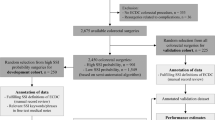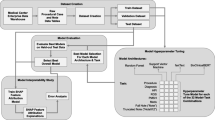Abstract
Postsurgical complications (PSCs) are known as a deviation from the normal postsurgical course and categorized by severity and treatment requirements. Surgical site infection (SSI) is one of major PSCs and the most common healthcare-associated infection, resulting in increased length of hospital stay and cost. In this work, we proposed an automated way to generate keyword features using sublanguage analysis with heuristics to detect SSI from cohort in clinical notes and evaluated these keywords with medical experts. To further validate our approach, we also applied different machine learning algorithms on cohort using automatically generated keywords. The results showed that our approach was able to identify SSI keywords from clinical narratives and can be used as a foundation to develop an information extraction system or support search-based natural language processing (NLP) approaches by augmenting search queries.



Similar content being viewed by others
References
Human TEI (2000) Building a safer health system. Institute of Medicine;112
Dindo D, Demartines N, Clavien P-A (2004) Classification of surgical complications: a new proposal with evaluation in a cohort of 6336 patients and results of a survey. Ann Surg 240:205–213
Gombotz H, Knotzer H (2013) Preoperative identification of patients with increased risk for perioperative bleeding. Curr Opin Anesthesiol 26:82–90
Nielsen AW, Helm MC, Kindel T, Higgins R, Lak K, Helmen ZM et al (2017) Perioperative bleeding and blood transfusion are major risk factors for venous thromboembolism following bariatric surgery. Surg Endosc:1–8
Pereira HO, Rezende EM, Couto BRGM (2015) Length of preoperative hospital stay: a risk factor for reducing surgical infection in femoral fracture cases. Rev Bras Ortop (English Edition) 50:638–646
Seymour DG, Pringle R (1983) coperative complications in the elderly surgical patient. Gerontology 29:262–270
Garth A, Newsome C, Simmance N, Crowe T (2010) Nutritional status, nutrition practices and post-operative complications in patients with gastrointestinal cancer. J Hum Nutr Diet 23:393–401
Faciszewski T, Winter RB, Lonstein JE, Denis F, Johnson L (1995) The surgical and medical perioperative complications of anterior spinal fusion surgery in the thoracic and lumbar spine in adults: a review of 1223 procedures. Spine 20:1592–1599
Tuman KJ, McCarthy RJ, March RJ, DeLaria GA, Patel RV, Ivankovich AD (1991) Effects of epidural anesthesia and analgesia on coagulation and outcome after major vascular surgery. Anesth Analg 73:696–704
Weiser TG, Haynes AB, Molina G, Lipsitz SR, Esquivel MM, Uribe-Leitz T, Fu R, Azad T, Chao TE, Berry WR, Gawande AA (2016) Size and distribution of the global volume of surgery in 2012, vol 94. World Health Organization Bulletin of the World Health Organization, pp 201–209F
Organization WH (2008) New checklist to help make surgery safer. Press release: New checklist to help make surgery safer. World Health Organization, Geneva
Fischer CL, Gill C, Forrester MG, Nakamura R (1976) Quantitation of “acute-phase proteins” postoperatively: value in detection and monitoring of complications. Am J Clin Pathol 66:840–846
Romano PS, Mull HJ, Rivard PE, Zhao S, Henderson WG, Loveland S, Tsilimingras D, Christiansen CL, Rosen AK (2009) Validity of selected AHRQ patient safety indicators based on VA National Surgical Quality Improvement Program data. Health Serv Res 44:182–204
Birkmeyer JD, Shahian DM, Dimick JB, Finlayson SR, Flum DR, Ko CY et al (2008) Blueprint for a new American College of Surgeons: national surgical quality improvement program. J Am Coll Surg 207:777–782
Fry DE, Pine M, Jones BL, Meimban RJ (2009) Adverse outcomes in surgery: redefinition of postoperative complications. Am J Surg 197:479–484
Henderson KE, Recktenwald AJ, Reichley RM, Bailey TC, Waterman BM, Diekemper RL, Storey PE, Ireland BK, Dunagan WC (2009) Clinical validation of the AHRQ postoperative venous thromboembolism patient safety indicator. Jt Comm J Qual Patient Saf 35:370–376
Gupta RM, Parvizi J, Hanssen AD, Gay PC (2001) Postoperative complications in patients with obstructive sleep apnea syndrome undergoing hip or knee replacement: a case-control study. Mayo Clinic Proceedings: Elsevier. p. 897–905
FitzHenry F, Murff HJ, Matheny ME, Gentry N, Fielstein EM, Brown SH, Reeves RM, Aronsky D, Elkin PL, Messina VP, Speroff T (2013) Exploring the frontier of electronic health record surveillance: the case of post-operative complications. Med Care 51:509–516
Murff HJ, FitzHenry F, Matheny ME, Gentry N, Kotter KL, Crimin K, Dittus RS, Rosen AK, Elkin PL, Brown SH, Speroff T (2011) Automated identification of postoperative complications within an electronic medical record using natural language processing. JAMA 306:848–855
Singh B, Singh A, Ahmed A, Wilson GA, Pickering BW, Herasevich V, et al. (2012) Derivation and validation of automated electronic search strategies to extract Charlson comorbidities from electronic medical records. Mayo Clinic Proceedings: Elsevier. p. 817–824
Hergenroeder K, Carroll T, Chen A, Iurillo C, Kim P, Terner Z et al (2014) Automated prediction of adverse post-surgical outcomes. Systems and Information Engineering Design Symposium (SIEDS). IEEE 2014:227–232
Soguero-Ruiz C, Hindberg K, Mora-Jiménez I, Rojo-Álvarez JL, Skrøvseth SO, Godtliebsen F, Mortensen K, Revhaug A, Lindsetmo RO, Augestad KM, Jenssen R (2016) Predicting colorectal surgical complications using heterogeneous clinical data and kernel methods. J Biomed Inform 61:87–96
Hsieh N-C, Hung L-P, Shih C-C, Keh H-C, Chan C-H (2012) Intelligent postoperative morbidity prediction of heart disease using artificial intelligence techniques. J Med Syst 36:1809–1820
Feis D-L, Schoene-Bake J-C, Elger C, Wagner J, Tittgemeyer M, Weber B (2013) Prediction of post-surgical seizure outcome in left mesial temporal lobe epilepsy. Neuroimage 2:903–911
Shen F, Liu H, Sohn S, Larson DW, Lee Y (2015) BmQGen: biomedical query generator for knowledge discovery. Bioinformatics and Biomedicine (BIBM), 2015 IEEE International Conference on: IEEE. p. 1092–7
Shen F, Liu H, Sohn S, Larson DW, Lee Y (2016) Predicate oriented pattern analysis for biomedical knowledge discovery. Intell Inf Manag 8:66–85
Sager N, Friedman C, Lyman MS (1987) Medical language processing: computer management of narrative data
Friedman C (2000) A broad-coverage natural language processing system. Proceedings of the AMIA Symposium: American Medical Informatics Association, p 270
Wang Y, Wang L, Rastegar-Mojarad M, Moon S, Shen F, Afzal N et al (2017) Clinical information extraction applications: a literature review. J Biomed Inform
Liu H, Sohn S, Murphy S, Lovely J, Burton M, Naessens J et al (2014) Facilitating post-surgical complication detection through sublanguage analysis. AMIA Summits on Translational Science Proceedings 2014:77
Kittredge R, Lehrberger J (1982) Sublanguage: studies of language in restricted semantic domains. Walter de Gruyter
Hintze R, Adler A, Veltzke W, Abou-Rebyeh H (1997) Endoscopic access to the papilla of Vater for endoscopic retrograde cholangiopancreatography in patients with billroth II or Roux-en-Y gastrojejunostomy. Endoscopy 29:69–73
Cheng Y-S, Li M-H, Chen W-X, Chen N-W, Zhuang Q-X, Shang K-Z (2004) Complications of stent placement for benign stricture of gastrointestinal tract. World J Gastroenterol 10:284–286
Control CfD, Prevention (2015) Surgical site infection (SSI) event. Procedure Associated Module (SSI) Centers for Disease Control and Prevention (CDC), Atlanta. 1–26
Complications. Found at: http://www.fascrs.org/physicians/education/core_subjects/2011/Complications. Accessed Jan 2018
Society of Interventional Radiology. Found at: http://www.sirweb.org/. Accessed Jan 2018
Taylor A. (1995) Extracting knowledge from biological descriptions. Proceedings of 2nd International Conference on Building and Sharing Very Large-Scale Knowledge Bases. p. 114–119
Johnson SB (1999) A semantic lexicon for medical language processing. J Am Med Inform Assoc 6:205–218
Hardy G, Littlewood J, Pólya G (1988) Inequalities. Reprint of the 1952 edition. Cambridge Mathematical Library. Cambridge University Press, Cambridge
Bodenreider O (2004) The unified medical language system (UMLS): integrating biomedical terminology. Nucleic Acids Res 32:D267–DD70
Church KW, Hanks P (1990) Word association norms, mutual information, and lexicography. Comput Linguist 16:22–29
Cover TM, Thomas JA (2012) Elements of information theory. Wiley
Friedl MA, Brodley CE (1997) Decision tree classification of land cover from remotely sensed data. Remote Sens Environ 61:399–409
Torii M, Wagholikar K, Liu H (2011) Using machine learning for concept extraction on clinical documents from multiple data sources. J Am Med Inform Assoc 18:580–587
Mohri M, Rostamizadeh A, Talwalkar A (2012) Foundations of machine learning. MIT press
Kohavi R (1995) A study of cross-validation and bootstrap for accuracy estimation and model selection. Ijcai, Stanford, pp 1137–1145
Bhargava N, Sharma G, Bhargava R, Mathuria M (2013) Decision tree analysis on j48 algorithm for data mining. Proc Int J Adv Res Comput Sci Softw Eng 3
Ho TK (1995) Random decision forests. Document analysis and recognition, 1995, proceedings of the third international conference on: IEEE. p. 278–82
Cortes C, Vapnik V (1995) Support-vector networks. Mach Learn 20:273–297
Eclipse Juno Integrated Development Environment. Found at: https://www.eclipse.org/juno/. Accessed by Jan 2018
Apache UIMA. Found at: https://uima.apache.org/
Weka. Found at: http://www.cs.waikato.ac.nz/ml/weka/
Kullback S, Leibler RA (1951) On information and sufficiency. Ann Math Stat 22:79–86
Pearson KX (1900) On the criterion that a given system of deviations from the probable in the case of a correlated system of variables is such that it can be reasonably supposed to have arisen from random sampling. The London, Edinburgh, and Dublin Philosophical Magazine and Journal of Science 50:157–175
Mukras R, Wiratunga N, Lothian R, Chakraborti S, Harper D (2007) Information gain feature selection for ordinal text classification using probability re-distribution. Proceedings of the Textlink workshop at IJCAI, p 16
McHugh ML (2013) The chi-square test of independence. Biochem Med 23:143–149
Feng C, Naik BI, Xin W, Ma JZ, Scalzo DC, Thammishetti S et al (2017) Haptoglobin 2-2 phenotype is associated with increased acute kidney injury after elective cardiac surgery in patients with diabetes mellitus. J Am Heart Assoc 6:e006565
Shen F, Wang L, Liu H (2017) Using human phenotype ontology for phenotypic analysis of clinical notes. Stud Health Technol Inform 245:1285
Shen F, Wang L, Liu H (2017) Phenotypic analysis of clinical narratives using human phenotype ontology. Stud Health Technol Inform 245:581–585
Shen F, Liu S, Wang Y, Wang L, Afzal N, Liu H (2017) Leveraging collaborative filtering to accelerate rare disease diagnosis. Am Med Inform Assoc
Shen F, Liu S, Wang Y, Wang L, Afzal N, Liu H (2017) Accelerating rare disease diagnosis with collaborative filtering. Am Med Inform Assoc
Mangram AJ, Horan TC, Pearson ML, Silver LC, Jarvis WR, Committee HICPA (1999) Guideline for prevention of surgical site infection, 1999. Am J Infect Control 27:97–134
Funding
This work was made possible by joint funding from National Institute of Health grants R01GM102282A1 and NIH R01 EB19403-1.
Author information
Authors and Affiliations
Corresponding author
Ethics declarations
Conflict of Interests
The authors declare that they have no conflict of interest.
Additional information
Publisher’s Note
Springer Nature remains neutral with regard to jurisdictional claims in published maps and institutional affiliations.
Rights and permissions
About this article
Cite this article
Shen, F., Larson, D.W., Naessens, J.M. et al. Detection of Surgical Site Infection Utilizing Automated Feature Generation in Clinical Notes. J Healthc Inform Res 3, 267–282 (2019). https://doi.org/10.1007/s41666-018-0042-9
Received:
Revised:
Accepted:
Published:
Issue Date:
DOI: https://doi.org/10.1007/s41666-018-0042-9




